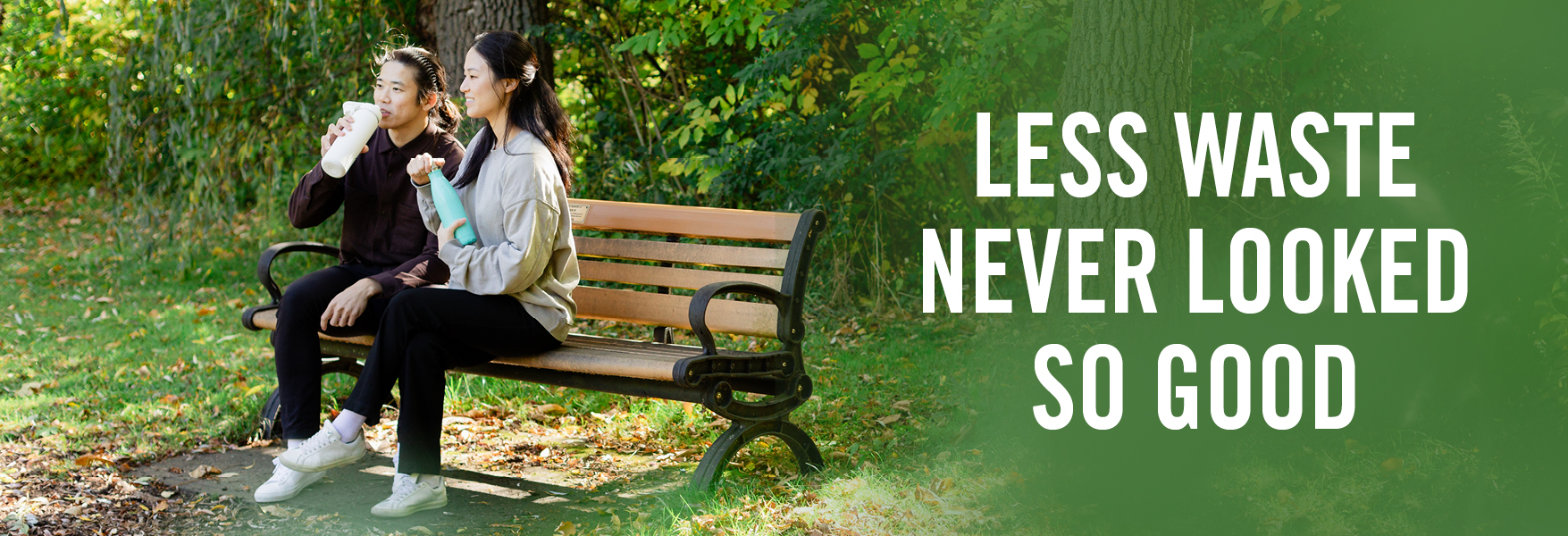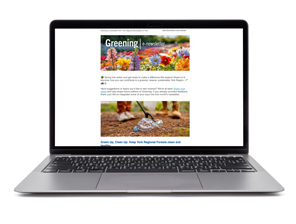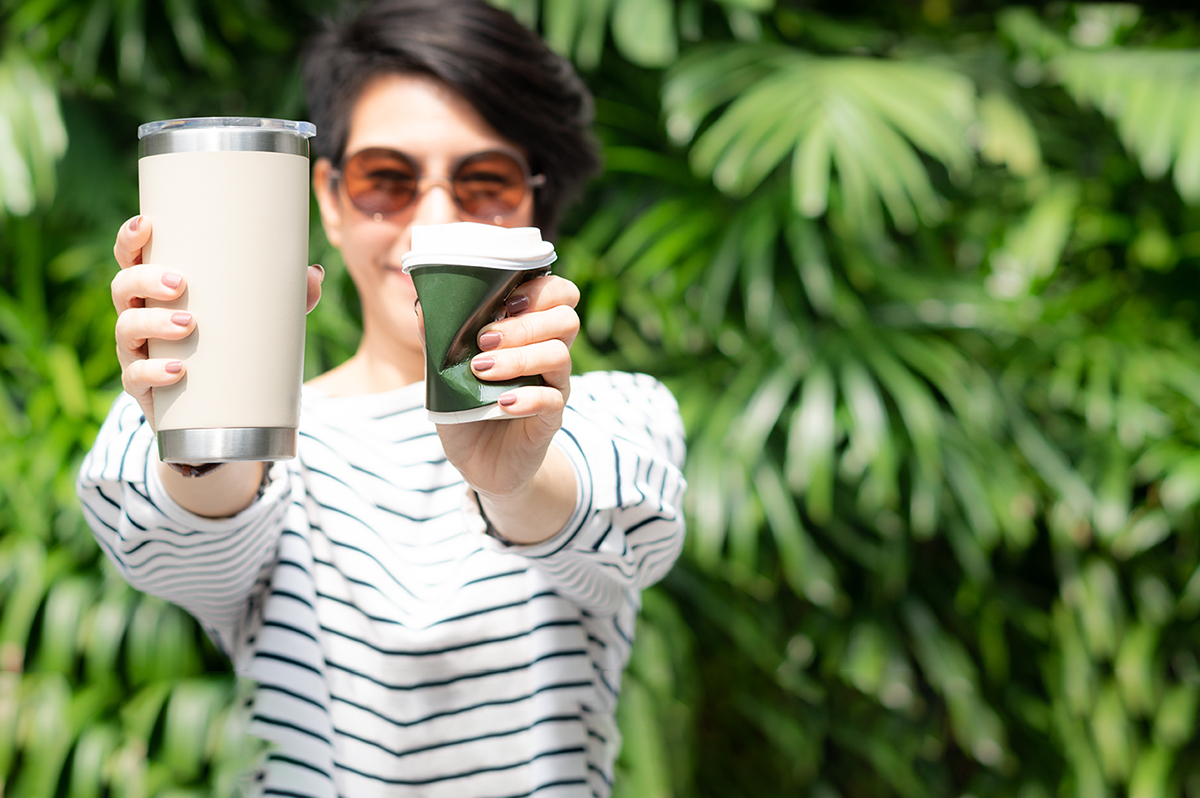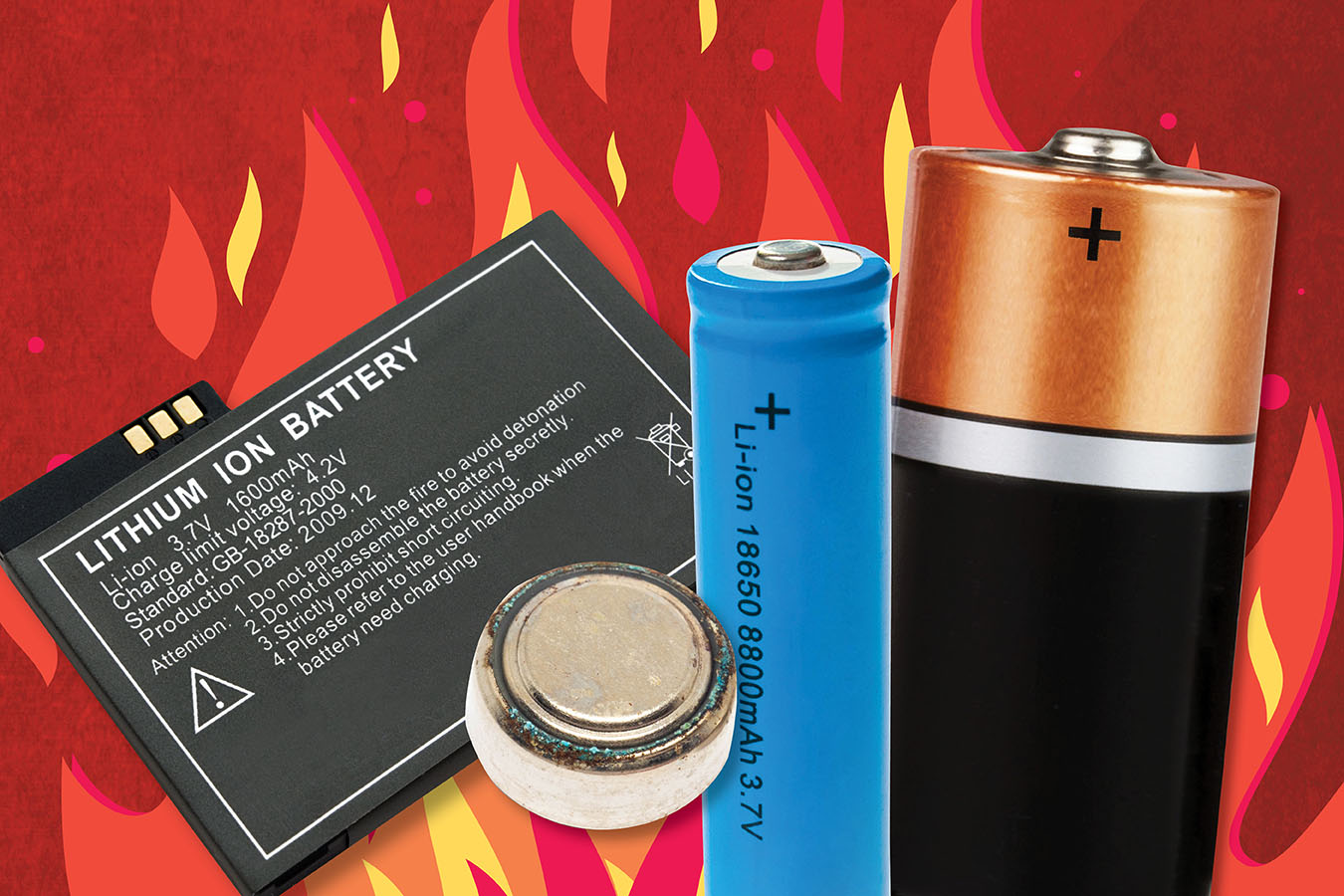Reduce Waste
Take the Plastic Free Challenge and say no to single-use items.

Single-use items are often made of hard-to-recycle plastics, designed to be used once and tossed away.
Common single-use items include: coffee pods, foam takeout containers, hot and cold takeout cups, plastic bags, plastic cutlery, plastic straws and stir sticks.
Why are Single-use Items an Issue?
They are often made of hard-to-recycle plastic.
Plastic is made from fossil fuels like natural gas and crude oil and contributes to greenhouse gas emissions.
Plastic takes hundreds of years to break down; and it only breaks down into tiny pieces called microplastics that contaminate the environment, including our water.
Single-use items often end up as litter in our parks, playgrounds, rivers and lakes, potentially harming people and wildlife.
Many single-use items are not recyclable and go in the garbage.
It’s difficult for people to know which items are recyclable and which are garbage. Non-recyclable items mistakenly placed in the blue box contaminate other items and reduce the recyclability and value of the materials that can be recycled.
Federal ban on Single-use Plastics
On June 20, 2022, the Government of Canada released its Single-Use Plastics Prohibition Regulations, a ban to stop the manufacture, import, sale and distribution of these six types of single-use plastics:
- Checkout bags for carrying purchased goods
- Cutlery including knives, forks, spoons, sporks and chopsticks
- Foodservice ware made from hard-to-recycle plastics; primarily containers for serving and transporting ready-to-consume foods or drinks like foam or black plastic containers
- Ring carriers used to transport beverages, like six-pack rings
- Stir sticks used for mixing beverages or preventing spills from beverage cup lids
- Straws with some exceptions like flexible plastic straws; this includes straight straws and those packaged with beverages, like juice boxes and drink pouches
For a more detailed explanation of all plastics banned refer to the Government of Canada’s Single-Use Plastics Prohibition Regulations – Technical Guidelines
Over the next decade, the ban will help eliminate over 1.3 million tonnes of hard-to-recycle plastic waste and more than 22,000 tonnes of plastic pollution, equivalent to over a million garbage bags full of litter1.
Reducing our reliance on plastics could reduce carbon emissions by 1.8 megatonnes annually2, helping to fight climate change and achieve the Region’s long-term goal of becoming a net-zero Region by 2050.
1https://www.canada.ca/en/environment-climate-change/news/2022/06/government-of-canada-delivers-on-commitment-to-ban-harmful-single-use-plastics.html
2https://www.canada.ca/en/environment-climate-change/news/2022/06/government-of-canada-delivers-on-commitment-to-ban-harmful-single-use-plastics.html
What does this ban mean for you?
As of December 20, 2023, these single-use plastic items will no longer be available in Canada.
Businesses may provide alternatives or you may need to bring your own, like reusable bags, cutlery or straws.
Ring carriers and straws packaged with beverages, like drink boxes, will be banned at a later date to give businesses more time to find alternative solutions.
Flexible plastic straws are an exception to the ban to accommodate people who need them for accessibility or health reasons. The sale and distribution of flexible plastic straws will be restricted in certain circumstances. For example, food service establishments and restaurants will not be able to provide these straws; you must bring your own.
Exceptions made for flexible plastic straws include:
- Manufacturing and importing will be allowed
- Anyone may purchase them in packages of 20 or more from retailers “by request only”; they will not be on display
- Care institutions such as hospitals, long-term care facilities and medical clinics can provide these straws to patients/clients as needed
For more details see Government of Canada’s Fact Sheet: Exceptions for single-use plastic flexible straws.
All other types of single-use plastic straws will be banned.
Timelines for ban to take effect | |||
|---|---|---|---|
| Single-use plastic item | Manufacture and import for use in Canada ends | Sale and distribution ends | Manufacture, import and sale for export |
| Checkout bags, cutlery, foodservice ware, stir sticks, straws* | December 20, 2022 | December 20, 2023 | December 20, 2025 |
| Ring carriers | June 20, 2023 | June 20, 2024 | December 20, 2025 |
| Flexible straws packaged with beverages | N/A | June 20, 2024 | December 20, 2025 |
*Does not include flexible straws or straws packaged with beverages.
For more details on this regulation please see the Government of Canada’s Single-Use Prohibition Regulations Overview.
What is Being Done to Reduce Single-use Items?
The Government of Canada is also working towards a circular economy by:
- Proposing large chain grocery stores implement a Pollution Prevention (P2) Plan to eliminate plastic waste from primary food packaging; this is any packaging that comes into direct contact with food
- Proposing a Regulatory Framework that would:
- Mandate companies to use at least 50% recycled content in their plastic products and packaging by 2030
- Require better labelling for plastic items so consumers can accurately and easily identify if they are recyclable, compostable or garbage
- Supporting efforts to make producers responsible for their products and packaging
The Ontario government is moving the blue box program to a producer responsibility model by December 31, 2025, making producers (the companies that design, make and sell products and packaging) fully responsible for managing the waste generated from their products and packaging.
By making producers fully responsible, they will:
- Create better products and packaging that is recyclable
- Put less packaging on their products
- Help develop better recycling technology and processes
What is York Region Doing?
York Region is working to support businesses and residents in reducing their use of single-use items.
In 2022 York Region launched a Single-Use Items Reduction campaign, and engaged with over 1,200 people about single-use alternatives and how to recycle or dispose of items properly at several events across the Region.
In 2021, public input was also collected. See below for results from these engagements:
Single-Use Items “What You Said” Report
Single-Use Items Business Survey Summary
For updates on future engagements and projects, please subscribe to our environmental newsletter, Splash.
The Single-Use Innovation Challenge
In 2023, York Region’s Single-Use Innovation Challenge provided $34,000 in funding to two non-profit organizations with unique, community-driven approaches to help York Region businesses reduce their use of single-use items.
This initiative was introduced to help educate and prepare businesses for the Government of Canada’s federal ban on single-use plastics that takes effect December 20, 2023.
The Single-Use Innovation Challenge recipients are:
- Ocean Ambassadors Canada who launched their Virtual Zero-Waste Coaching program to help York Region small businesses reduce their use of single-use items and move toward less wasteful practices like offering reusable alternatives
- Vaughan Chamber of Commerce (VCC) through its Sustainable Business Vaughan (SBV) Initiative provides resources to the hospitality and tourism industry to help them transition from using single-use items, including a free workshop, toolkits and other resources.
Facts and Stats
Canada
- We use between 9 and 15 billion plastic bags a year, which is enough to circle the globe 55 times (Toronto Sun, 2017)
- More than a billion used coffee pods make their way into Canadian landfills every year (TVO, 2017)
- More than 1 billion plastic bottles are thrown away and not recycled in Ontario every year (Environmental Defence)
- 57 million straws are used every day (The Globe and Mail, 2018)
- 2.6 million single-use beverage containers go to Vancouver landfills every week (Global News, 2017)
- We generate 3.25 million tonnes of plastic waste – 140,000 garbage trucks’ worth – each year (Huffington Post, 2018)
- In 2010, Canada released about 8,000 tonnes of plastic waste into waterways (Government of Canada, 2018)
- Since 1994, 700,000 volunteers have collected more than 1.2 million kg of waste from shorelines across Canada (Government of Canada, 2018)
- 80 per cent of litter in the Great Lakes is plastic (Environmental Defence)
- Canada recycles 11 per cent of all plastics produced (Global News, 2018)
Global
- Annually approximately 500 billion plastic bags are used worldwide. More than one million bags are used every minute (EcoWatch, 2014)
- Americans use 100 billion plastic bags a year, which require 12 million barrels of oil to manufacture (Center for Biological Diversity)
- Roughly 4.9 billion tons of plastic waste produced since the 1950s hasn’t been recycled or burned; plastic production is expected to double over the next two decades (Axois, 2018)
- 275 million metric tonnes of plastic waste was generated in 192 coastal countries in 2010, with 4.8 to 12.7 million metric tonnes entering the ocean (ScienceMag, 2015)
- Enough plastic is thrown away each year to circle the earth four times (Reuse This Bag, 2018)
- The average American family takes home almost 1,500 plastic shopping bags a year (Natural Resources Defense Council, 2008)
- Plastic bags are used for an average of 12 minutes (Environment Massachusetts)

Stay current on York Region’s environmental news, programs, services and events.
Sign up for our Greening e-Newsletter.
take charge of your batteries
All batteries are hazardous waste. They contain combustible, flammable materials and must never go in the garbage or recycling. Learn more about safety tips and drop-off locations.





